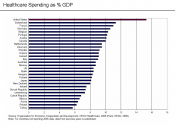The United States health care system developed much in the same way that our country developed, by way of capitalism. Instilled within our system of values and political ideology and philosophy is the idea that a person should be able to take care of their own matters, that the duty of government is to provide equally for all for the public good, and that no infringement of personal liberties should be allowed in either case. Intrinsic in these views lays the foundations of capitalism and a "laissez faire" philosophy on many government dealings. Health care, in this sense, then followed the path of the development of business and industry in the U.S. The major changes in health care can be seen through the rise of the power of the physicians, the rise in the advancement of health care technology as well as the desire for Americans to have access to the newest procedures and medications, and the need for some form of healthcare insurance.
Health care in the U.S., in its current state, really came to fruition in the early 20th century. This is a natural progression, as more population growth was occurring, and a greater need for infrastructure, both in the private and public sectors, was necessary. After World War II, the thought process in creating health care infrastructure veered away from any form of socialized healthcare (Mahar 4). This seems to be a major misstep, though it's understandable at the time why politicians and physicians would censure such ideas due to the heightened political atmosphere after the war. The founding of the AMA however, really placed the power and the profit in the hands of the physicians (Mahar 4-10). The physicians already had power over the patients through knowledge. Patients rely on doctors because they are trained professionals,



Informative essay about the health care
this paper is well defined about the usa health system
1 out of 1 people found this comment useful.